8.5.2 Census data entry - LUPMISManual
Main menu:
- 0. Introduction
- 1. GIS handling
-
2. GIS data entry
- 2.1 Create new layer
- 2.2 Digitize line
- 2.3 Digitize point
- 2.4 Digitize polygon
- 2.5 Edit existing layer
- 2.6 Delete feature
- 2.7 Split line
- 2.8 Split polygon
- 2.9 Merge lines from different layers
- 2.10 Unite lines
- 2.11 Snap lines
- 2.12 Join polygons
- 2.13 Extend polygon
- 2.14 Insert island
- 2.15 Define unit surrounding islands
- 2.16 Create 'doughnut'
- 2.17 Fill 'doughnut' polygon
- 2.18 Fill polygon with 'holes'
- 2.19 Digitize parcels from sector layout
-
3. GIS operations
- 3.1 Create buffer
- 3.2 Create exclusion zone
- 3.3 Overlay units
- 3.4 Convert line to polygon
- 3.5 Derive statistics (area size, length)
- 3.6 Clip unit according to other unit
- 3.7 Create geographic grid
- 3.8 Move entire vector map
- 3.9 Move or copy individual features on a map
- 3.10 Adjust polygon to line
- 3.11 Convert points to polygon
- 3.12 Define by distance
- 3.13 Create multiple objects
- 3.14 Transfer styles from one layer to another
-
4. Attribute database
- 4.1 Start with database
- 4.2 Import database
- 4.3 Display database information
- 4.4 Enter attribute data
- 4.5 Attribute matrix of multiple layers
- 4.6 Seeds
- 4.7 Repair attribute data
- 4.8 Merge lines with attached database
- 4.9 Transfer attribute data from points to polygons
- 4.10 Copy styles, labels, attributes
-
5. Conversion of data
-
5.1 Points
- 5.1.1 Import list of points from text file
- 5.1.2 Import list of points from Excel file
- 5.1.3 Convert point coordinates between projections
- 5.1.4 Convert point coordinates from Ghana War Office (feet)
- 5.1.5 Convert point coordinates from Ghana Clark 1880 (feet)
- 5.1.6 Track with GPS
- 5.1.7 Download GPS track from Garmin
- 5.1.8 Download GPS track from PDA
- 5.1.9 Frequency analysis of points
- 5.2 Vector maps
- 5.3 Raster maps
-
5.4 Communication with other GIS programs
- 5.4.1 Import GIS data from SHP format
- 5.4.2 Import GIS data from E00 format
- 5.4.3 Import GIS data from AutoCAD
- 5.4.4 Export LUPMIS data to other programs
- 5.4.5 Export GIS to AutoCAD
- 5.4.6 Change a shape file to GPX
- 5.4.7 Transfer GIS data to other LUPMIS installations
- 5.4.8 Digitize lines in Google Earth
- 5.5 Terrain data
- 5.6 Export to tables
- 5.7 Density map
-
5.1 Points
-
6. Presentation
- 6.1 Labels
- 6.2 Styles and Symbols
- 6.3 Marginalia
- 6.4 Legend
- 6.5 Map template
- 6.6 Final print
- 6.7 Print to file
- 6.8 3D visualization
- 6.9 External display of features
- 6.10 Google
-
7. GIS for land use planning
- 7.1 Introduction to land use planning
- 7.2 Land use mapping for Structure Plan
- 7.3 Detail mapping for Local Plan
- 7.4 Framework
- 7.5 Structure Plan
- 7.6 Local Plan
- 7.7 Follow-up plans from Local Plan
- 7.8 Land evaluation
-
8. LUPMIS Tools
- 8.1 General
-
8.2 Drawing Tools
- 8.2.1 Overview
- 8.2.2 UPN
- 8.2.3 Streetname + housenumbers
- 8.2.4 Lines
- 8.2.5 Arcs
- 8.2.6 Polygons
- 8.2.7 Points
- 8.2.8 Cut line
- 8.2.9 Other Drawing Tools
- 8.2.10 Import
- 8.2.11 Projections + conversions
- 8.2.12 Format conversion
- 8.2.13 Other GIS Tools
- 8.2.14 Utilities
- 8.3 Printing Tools
- 8.4 Permit Tools
- 8.5 Census Tools
-
8.6 Revenue Tools
- 8.6.1 Overview
- 8.6.2 Entry of revenue data
- 8.6.3 Retrieval of revenue data
- 8.6.4 Revenue maps
- 8.6.5 Other revenue tools
- 8.7 Reports Tools
- 8.8 Project Tools
- 8.9 Settings
-
9. Databases
- 9.1 Permit Database
-
9.2 Plans
- 9.2.1 Accra
- 9.2.2 Kasoa
- 9.2.3 Dodowa
- 9.2.4 Sekondi-Takoradi
-
9.3 Census Database
-
9.4 Revenue Database
-
9.5 Report Database
-
9.6 Project Database
- 9.7 Address Database
-
Annexes 1-10
- A1. LUPMIS setup
- A2. Background to cartography/raster images
- A3. Glosssary
- A4. Troubleshooting
- A5. Styles
- A6. Classification for landuse mapping/planning
- A7. GIS utilities
- A8. Map projection parameters
- A9. Regions / Districts
- A 10. Standards
-
Annexes 11-20
- A11. LUPMIS distribution
- A12. Garmin GPS
- A13. Training
- A14. ArcView
- A15. Population statistics
- A16. Entry and display of survey data
- A17. External exercises
- A18. Programming
- A19. Paper sizes
- A20. Various IT advices
- A21. Site map and references
8.5.2 Census Data Entry
Level of expertise required for this Chapter: Intermediate; specifically for LUPMIS @ TCPD
This Web page is still under construction and incomplete. It will be updated and complete shortly.
8.5.2.1 Manual Census Data Entry for Settlements:
Data of settlements can be entered, individually for each settlement, for population numbers, function, number of households, houses etc. Choose Entry > Settlement.
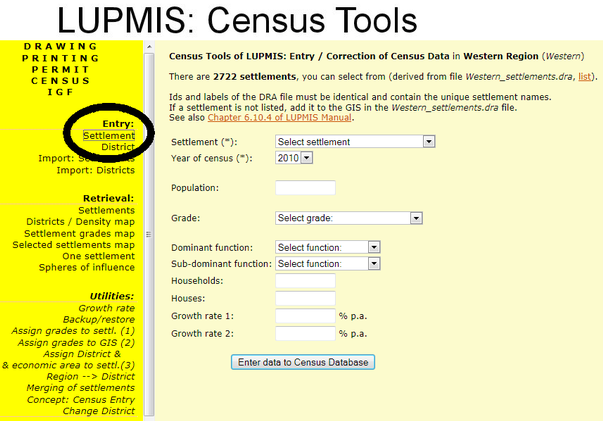
You first select the settlement and the census year, then enter the data.
Technical note: This requires the file xxx_settlements.dra (where xxx = name of District/Region, e.g. Western_settlements.dra) in your LUPMIS. All settlements of this list are derived from the GIS. To add a 'new' settlement, you have to enter it first in the GIS (DRA file).
8.5.2.2 Manual Census Data Entry for Districts:
Data for entire Districts can be entered for their population, also for infrastructure and production figures, as shown below. Choose Entry > District.
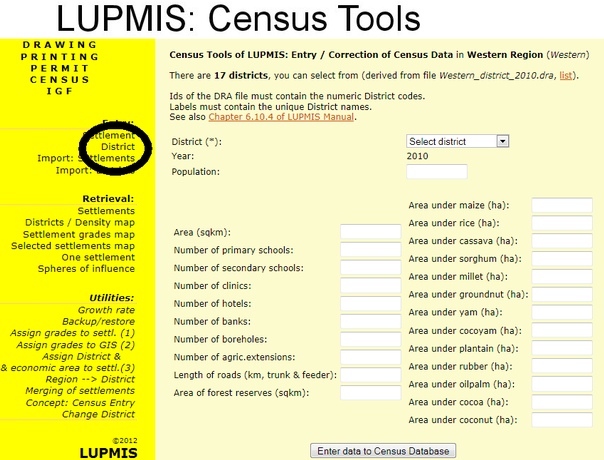
Because these data are year-specific and Districts are changing over time, you first define the year. LUPMIS will then access the District map (DRA file) of that specific year.
Technical note: The GIS District file should have the name <name of district>_district_<year>.dra, e.g. Western_district_2010.dra.
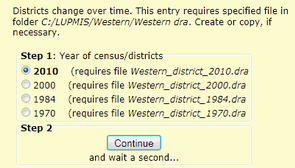
Technical note: This requires the file xxx_district_yyyy.dra (where xxx = name of District/Region, yyyy = year, e.g. Western_district_2010.dra) in your LUPMIS. All Districts of this list are derived from the GIS. To add a 'new' District, you have to enter it first in the GIS (DRA file).
8.5.2.3 Census Data Import for Settlements
A faster way to enter data to the Census Database is the direct import of a table. Similar to manual entry, there is a difference between settlements and Districts/Regions.
For the import of settlement tables, choose Entry > Import: Settlements
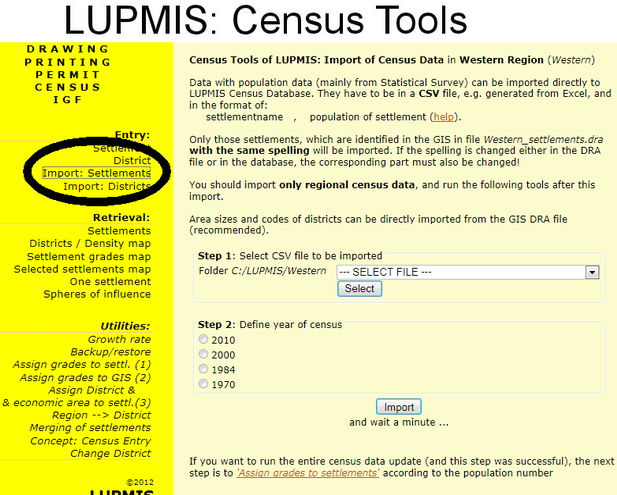
The import table should be a CSV table, which can be derived from Excel (Save As > CSV file) in the format of: name of settlement or District/Region , population figure . It is very important, that the spelling of settlement names is consistent, i.e. the same in the CSV file and in the GIS. If a name is to be changed, it has to be changed both in the import file and in the GIS.
Technical note: CSV files are ASCII files, with commas separating the values. Don't enter any commas in the data.
Example for a CSV import file for settlement population:
Takoradi,54772
Effiakuma,34307
Tarkwa,30631
8.5.2.4 Census Data Import for Districts
For the import of District tables, choose Entry > Import: Districts
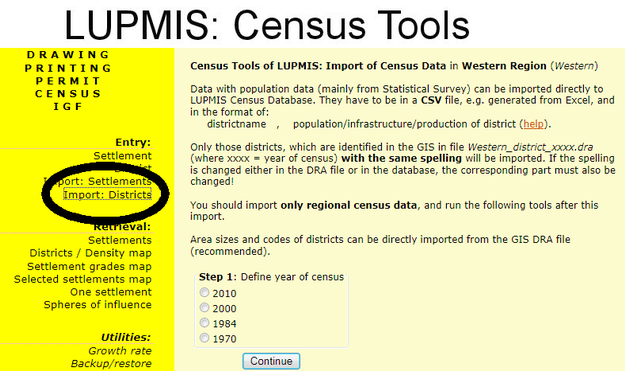
As District figures, do not only refer to population numbers, but also to infrastructure (schools, clinics etc) and to production figures (agriculture, forest etc), the type of information will be selected in the next menu.
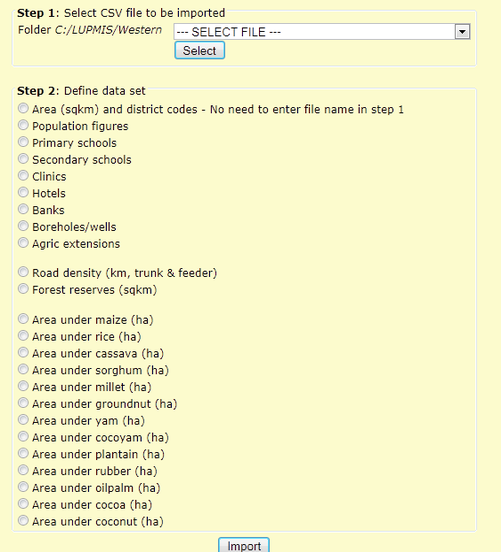
The same criteria for CSV files apply as explained in the previous Chapter.
8.5.2.5 Census Data Edit
You can edit the census data, if a population record already exists for the selected settlement/District/Region.
It is also possible to enter the edit mode including deleting option through Retrieval > Settlements/Districts > ... >Tic: With edit options. There is an edit/delete button at each population record on the right side.
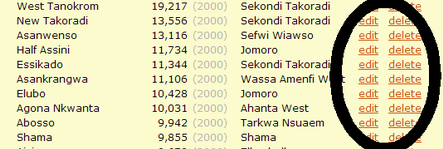
After entry of census data, they should be processed before full data analyses can be performed: See Chapter 8.5.6.

